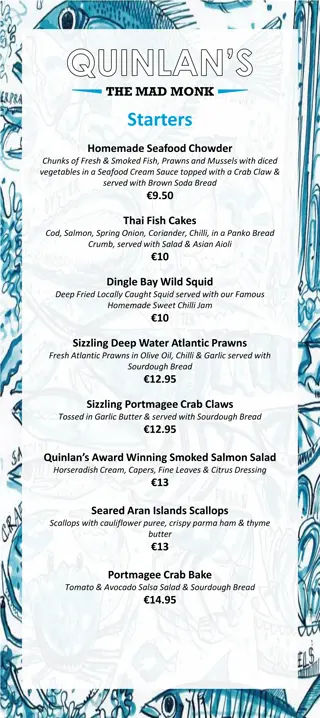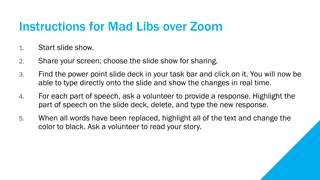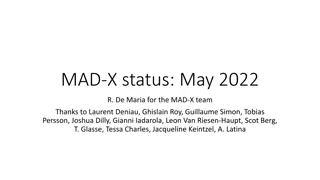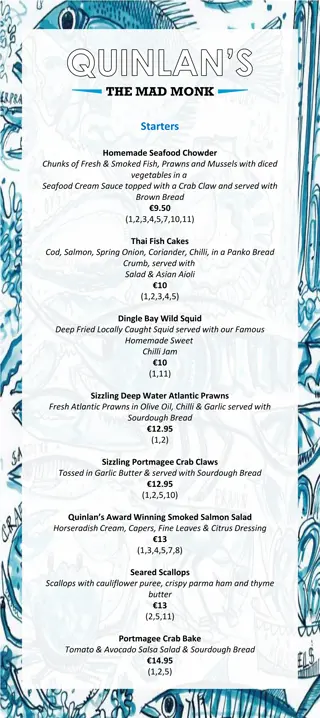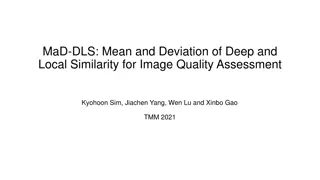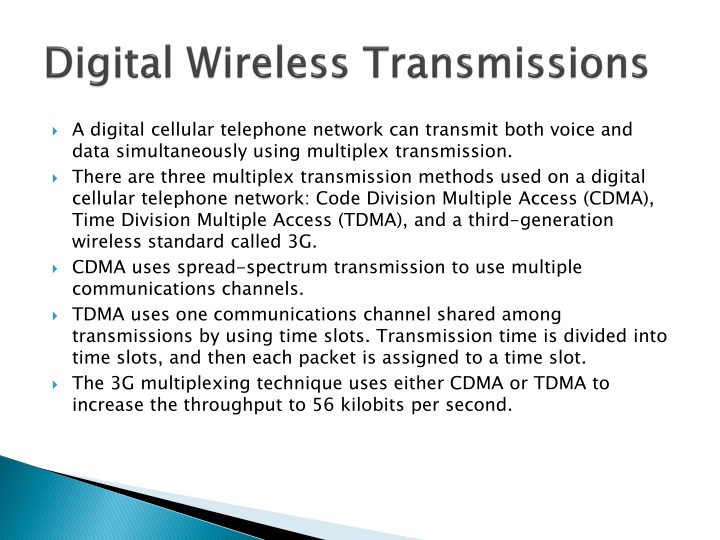
Digital Cellular Telephone Networks: Multiplex Transmission Methods Explained
Learn about the multiplex transmission methods - CDMA, TDMA, and 3G - used in digital cellular telephone networks to transmit voice and data simultaneously. Explore the evolution from traditional keypads to T9 technology, and discover the messaging services like SMS and CBS offered by cellular telephone companies for wireless communication.
Download Presentation

Please find below an Image/Link to download the presentation.
The content on the website is provided AS IS for your information and personal use only. It may not be sold, licensed, or shared on other websites without obtaining consent from the author. If you encounter any issues during the download, it is possible that the publisher has removed the file from their server.
You are allowed to download the files provided on this website for personal or commercial use, subject to the condition that they are used lawfully. All files are the property of their respective owners.
The content on the website is provided AS IS for your information and personal use only. It may not be sold, licensed, or shared on other websites without obtaining consent from the author.
E N D
Presentation Transcript
A digital cellular telephone network can transmit both voice and data simultaneously using multiplex transmission. There are three multiplex transmission methods used on a digital cellular telephone network: Code Division Multiple Access (CDMA), Time Division Multiple Access (TDMA), and a third-generation wireless standard called 3G. CDMA uses spread-spectrum transmission to use multiple communications channels. TDMA uses one communications channel shared among transmissions by using time slots. Transmission time is divided into time slots, and then each packet is assigned to a time slot. The 3G multiplexing technique uses either CDMA or TDMA to increase the throughput to 56 kilobits per second.
Traditional cellular telephones have a keypad that contains numbers and letters. (European traditional cellular telephones have only numbers.) Letters were designed to identify telephone exchanges local switching stations that serviced a group of customers. Each switching station was referred to by a name that implied the location of the switching station. For example, there was a switching station called Murray Hill that covered the Murray Hill section of New York City. The first two letters of the name of the switching station were used to replace the first two digits of a seven-digit phone number. Let s say a customer was assigned Murray Hill 5 1000 as a telephone number. A caller dials MU 5 1000.
Another solution is to use T9 technology. T9 technology uses special glasses that track eye movement, enabling a person to type by moving her eyes in one of eight directions. Multiple letters are assigned to each direction. An algorithm was developed that predicted which one of the multiple letters a person wanted to type based on the previous letters that she selected. Let s say you entered 546. The number 5 could represent the letters JKL.
One of the first popular wireless mobile communications devices was a pager. A pager displays any series of numbers that were sent by a caller. Technically, the series of numbers represented the caller s telephone number and implied that the call be returned. Practically, the series of numbers could represent anything to which the caller and the receiver agreed on. For example, it was common for systems administrators to have their system send a 911 call to a pager whenever there was a systems problem. Today s wireless mobile communications devices offer text messaging services that enable short textual messages to be sent to the device from any device that has access to the service. Cellular telephone companies offer three types of messaging services: Short Message Service (SMS), Cell Broadcast Service (CBS), and Unstructured Supplementary Services Data (USSD).
SMS type of messaging is capable of sending a maximum of 160 characters on the control channel of a cellular telephone network. The CBS type of messaging broadcasts a maximum of 15 pages of 93 characters per page to every device on the network. Everyone on the network receives the same message, which is why CBS messaging has had limited success in the market. The USSD type of messaging transmits a maximum of 182 characters along the control channel, similar to SMS messaging. However, USSD messaging does not use store forwarding technology. Instead, USSD messaging sends the message directly to the receiver, which enables the receiver to respond instantaneously.
A personal digital assistant (PDA) is probably the most commonly used small mobile computing device next to a cellular telephone. PDAs are lightweight and small enough to fit in a pocket, and they run essential applications. PDA is a generic name that applies to a simple digital telephone directory and to more elaborate mobile computing devices that run a spreadsheet, word processor, email, and a variety of customized programs. All PDAs are small computing devices that contain an operating system, processor, memory, and a port to connect the PDA to peripherals and external computing devices. There are three commonly used operating systems on a PDA: EPOC, Palm OS, and Windows CE. EPOC is used in the Psion product line, Palm OS in the Palm PDAs, and Windows CE on various pocket PC devices.
Memory is precious in a PDA. A PDA does not have permanent storage, therefore all the applications and data running in a PDA must reside in memory. PDAs use ROM and RAM. ROM is used to store bundled applications from the factory. These include a word processor, spreadsheet, diary, telephone directory, and other kinds of programs that you expect to find in a PDA. Applications that are not bundled with the PDA, and data for all applications including those that reside in ROM, are stored in RAM.
PDAs use one of three types of RAM: Dynamic RAM (DRAM), Enhanced Data Output (EDO), and Synchronous Dynamic RAM (SDRAM). DRAM is the least expensive RAM. EDO is found in some PDAs, and SDRAM is very rarely used. Generally the more RAM installed in a computer, the better the computer s performance, but this is not necessarily true with PDAs. The amount of RAM that affects performance depends on the PDA s operating system.Windows CE requires more memory (32MB) to perform basic functions than a Palm (4MB).
Using J2ME you can develop practically any application that you can imagine for a small computing device. The only limitations are those posed by available resources on the small computing device and your skills as a J2ME programmer. A small computing device is constrained by its resources, as you learned previously in this book. Writing a J2ME application is not unlike writing any Java application. You use the same basic programming constructs as used in a J2SE app Using J2ME you can develop practically any application that you can imagine for a small computing device. The only limitations are those posed by available resources on the small computing device and your skills as a J2ME programmer. A small computing device is constrained by its resources, as you learned previously in this book. Writing a J2ME application is not unlike writing any Java application. You use the same basic programming constructs as used in a J2SE application
The modular design of the J2ME architecture enables an application to be scaled based on constraints of a small computing device. J2ME architecture doesn t replace the operating system of a small computing device. Instead, J2ME architecture consists of layers located above the native operating system, collectively referred to as the Connected Limited Device Configuration (CLDC). The CLDC, which is installed on top of the operating system, forms the run environment for small computing de The modular design of the J2ME architecture enables an application to be scaled based on constraints of a small computing device. J2ME architecture doesn t replace the operating system of a small computing device. Instead, J2ME architecture consists of layers located above the native operating system, collectively referred to as the Connected Limited Device Configuration (CLDC). The CLDC, which is installed on top of the operating system, forms the run- -time environment for small computing devices. time
The J2ME architecture comprises three software layers (Figure 3 The first layer is the configuration layer that includes the Java Virtual Machine (JVM), which directly interacts with the native operating system. The configuration layer also handles interactions between the profile and the JVM. The second layer is the profile layer, which consists of the minimum set of application programming interfaces (APIs) for the small computing device. The third layer is the Mobile Information Device Profile (MIDP). The MIDP layer contains Java APIs for user network connections, persistence storage, and the user interface. It also has access to C The J2ME architecture comprises three software layers (Figure 3- -1). The first layer is the configuration layer that includes the Java Virtual Machine (JVM), which directly interacts with the native operating system. The configuration layer also handles interactions between the profile and the JVM. The second layer is the profile layer, which consists of the minimum set of application programming interfaces (APIs) for the small computing device. The third layer is the Mobile Information Device Profile (MIDP). The MIDP layer contains Java APIs for user network connections, persistence storage, and the user interface. It also has access to CLDC libraries and MIDP libraries. 1).
A small computing device has two components supplied by the original equipment manufacturer (OEM). These are classes and applications. OEM classes are used by the MIDP to access device receiving messages and accessing device specific persistent data. OEM applications are programs provided by the OEM, such as an address book. OEM applications can be accessed by the MIDP. A small computing device has two components supplied by the original equipment manufacturer (OEM). These are classes and applications. OEM classes are used by the MIDP to access device- -specific features such as sending and receiving messages and accessing device- - specific persistent data. OEM applications are programs provided by the OEM, such as an address book. OEM applications can be accessed by the MIDP. specific features such as sending and
There are minimum resource requirements for a small computing device to run a J2ME application. First the device must have a minimum of 96 pixel display that can handle bitmapped graphics and have a way for users to input information, such as a keypad, keyboard, or touch screen. At least 128 kilobytes (KB) of nonvolatile memory is necessary to run Mobile Information Device (MID), and 8KB of nonvolatile memory is needed for storage of persistent application data. To run JVM, 32KB of volatile memory must be available. The device must also provide two network connectivity. There are minimum resource requirements for a small computing device to run a J2ME application. First the device must have a minimum of 96 54 pixel display that can handle bitmapped graphics and have a way for users to input information, such as a keypad, keyboard, or touch screen. At least 128 kilobytes (KB) of nonvolatile memory is necessary to run Mobile Information Device (MID), and 8KB of nonvolatile memory is needed for storage of persistent application data. To run JVM, 32KB of volatile memory must be available. The device must also provide two- -way network connectivity. 54 way
Short for MIDP is a set of software phones and two Applications conforming to this standard are called Companies that have worked on the MIDP include Ericsson, NEC, Nokia, NTT Palm Computing, Research In Motion (RIM), DoCoMo Short for Mobile MIDP is a set of J2ME software applications phones and two- -way pagers. Applications conforming to this standard are called MIDlets Companies that have worked on the MIDP include Ericsson, NEC, Nokia, NTT DoCoMo Palm Computing, Research In Motion (RIM), DoCoMo, LG Mobile Information J2ME APIs applications interface with cellular way pagers. Information Device APIs that define how interface with cellular Device Profile that define how Profile. . MIDlets. . DoCoMo, , , LG TeleCom TeleCom, Samsung and Motorola. , Samsung and Motorola.
A A pager personal messages. A one receive a message consisting of a few digits, typically a phone number that the user is then requested to call. Alphanumeric pagers are available, as well as two the ability to send and receive pages, and pager (often called a personal telecommunications messages. A one- -way numeric pager can only receive a message consisting of a few digits, typically a phone number that the user is then requested to call. Alphanumeric pagers are available, as well as two- -way pagers that have the ability to send and receive email pages, and SMS (often called a beeper) is a simple telecommunications device for short way numeric pager can only beeper) is a simple device for short way pagers that have email, numeric messages , numeric SMS messages
The first practical pager was introduced in 1950 by physicians in the New York City area. The first pager system had a range of approximately 40 km (25 mi) and the physicians paid US$12 per month for the service. The actual pager device was developed and manufactured by Reevesound Company of New York and weighed approximately 200 grams
A run just runtime support the execution of computer programs written in some computer language. The run-time system contains implementations of basic low-level commands and may also implement higher-level commands and may support type checking, debugging, and even code generation and optimization. Some services of the run-time system are accessible to the programmer through an application programming interface, but other services (such as task scheduling and resource management) may be inaccessible. run- -time system runtime) is a software component designed to time system (also called runtime system runtime system or
A operate on an MIDP small computing device. A class that is derived from the javax.microedition.midlet.MIDlet class. Members of a the host environment and share the same instances of Java classes and run within the same JVM. A MIDlet operate on an MIDP small computing device. A MIDlet class that is derived from the javax.microedition.midlet.MIDlet abstract class. Members of a MIDlet the host environment and share the same instances of Java classes and run within the same JVM. MIDlet is a J2ME application designed to is a J2ME application designed to MIDlet is defined with at least a single is defined with at least a single abstract MIDlet suite share resources of suite share resources of
data errors caused by concurrent read/write access to data. Sharing data among data errors caused by concurrent read/write access to data. Sharing data among MIDlets MIDlets exposes each exposes each MIDlet MIDlet to to This risk is reduced by synchronization primitives on the MIDlet persistent data. This risk is reduced by synchronization primitives on the MIDlet suite level that restrict access to volatile data and persistent data. suite level that restrict access to volatile data and However, if a responsible for coordinated access to the record store. However, if a MIDlet responsible for coordinated access to the record store. MIDlet uses multi uses multi- -threading, the threading, the MIDlet MIDlet is is Once a MIDlet by the application manager. Likewise, a to interact with the user persistent storage. Once a MIDlet MIDlet suite is given access to classes of the JVM and CLDC by the application manager. Likewise, a MIDlet to interact with the user interface,network persistent storage. MIDlet suite is installed, each member of the suite is given access to classes of the JVM and CLDC suite is installed, each member of the MIDlet can access classes defined in the MIDP interface,network, and can access classes defined in the MIDP , and The application manager also makes the Java archive (JAR) file and the Java application descriptor (JAD) file available The application manager also makes the Java archive (JAR) file and the Java application descriptor (JAD) file available
In software, JAR format typically used to aggregate many Java class files and associated metadata and resources (text, images and so on) into one file to distribute application software or libraries on the Java platform.[1] JAR files are built on the ZIP file format and have the .jar file extension. Computer users can create or extract JAR files using the jar command that comes with a JDK. They can also use zip tools to do so; however, the order of entries in the zip file headers is important when compressing, as the manifest often needs to be first. JAR (J Java AR ARchive) is a archive file
All the files necessary to implement a must be contained within a production package called a Java archive (JAR) file. All the files necessary to implement a MIDlet must be contained within a production package called a Java archive (JAR) file. MIDlet suite suite These files include (if required by a These files include MIDlet (if required by a MIDlet MIDlet classes, graphic images MIDlet), and the manifest file. classes, graphic images ), and the manifest file. The manifest file contains a list of attributes and related definitions that are used by the application manager to install the files contained in the JAR file onto the small computing device. Nine attributes are defined in the manifest file; all but six of these attributes are op The manifest file contains a list of attributes and related definitions that are used by the application manager to install the files contained in the JAR file onto the small computing device. Nine attributes are defined in the manifest file; all but six of these attributes are optional.
Java Application Descriptor the MIDlets (Java ME applications) that are distributed as JAR files. JAD files are commonly used to package Java applications or games that can be downloaded to mobile phones. Java applications enable mobile phones to interact functionally with online web services, such as the ability to send SMS messages via GSM mobile Internet or interact in multiplayer games. Some BlackBerry devices use JAD files for themes. Java Application Descriptor (JAD) files describe
Java application descriptor Filename extension .jad Internet media type text/vnd.sun.j2me.app-descriptor Developed by Sun Microsystems, Inc. Type of format Descriptor file Standard(s) Java application
You may include a Java application descriptor (JAD) file within the JAR file of a MIDlet a a MIDlet . A JAD file is also used to provide the application manager with additional content information about the JAR file to determine whether the implemented on the device You may include a Java application descriptor (JAD) file within the JAR file of a MIDlet suite as a way to pass parameters to MIDlet without modifying the JAR file . . A JAD file is also used to provide the application manager with additional content information about the JAR file to determine whether the MIDlet implemented on the device. . suite as a way to pass parameters to without modifying the JAR file . MIDlet suite can be suite can be
On the Java platform, a Manifest file file contained within a JAR archive. It is used to define extension and package-related data. It is a metadata file that contains name-value pairs organized in different sections. If a JAR file is intended to be used as an executable file, the manifest file specifies the main class of the application. The manifest file is namedMANIFEST.MF. It is not uncommon to find a computer file described as a manifest in situations unrelated to Java. Manifest file is a specific
The manifest files extension is changed to .mf when the MIDlet MIDlet MIDlet MIDlet Best.BestMIDlet MicroEdition MicroEdition The manifest file s extension is changed to .mf when the MIDlet MIDlet- -Name: Best MIDlet- -Version: 2.0 MIDlet- -Vendor: MIDlet- -1: Best.BestMIDlet MicroEdition- -Profile: MIDP MicroEdition- -Configuration: CLDC MIDlet is prepared for deployment. Name: Best MIDlet Version: 2.0 Vendor: MyCompany 1: BestMIDlet is prepared for deployment. MIDlet MyCompany BestMIDlet, /images/BestMIDlet.png, , /images/BestMIDlet.png, Profile: MIDP- -1.0 Configuration: CLDC- -1.0 1.0 1.0
Lets step through the manifest file shown in Listing 3 The Best The number of the MIDlet Let s step through the manifest file shown in Listing 3- -1. The MIDlet Best MIDlet The MIDlet number of the MIDlet suite and the company or person who provided the 1. MIDlet- -Name attribute specifies the name of the MIDlet in this example. MIDlet- -Version and Name attribute specifies the name of the MIDlet in this example. Version and MIDlet MIDlet suite, which is suite, which is MIDlet- -Vendor attributes identify the version Vendor attributes identify the version suite and the company or person who provided the MIDlet MIDlet suite. suite. The JAR file. The number of the replaced with the digit 1 because there is only one The MIDlet JAR file. The number of the MIDlet replaced with the digit 1 because there is only one MIDlet MIDlet- -n attribute contains information about each n attribute contains information about each MIDlet MIDlet that is in the that is in the MIDlet replaces the letter replaces the letter n. In this example, the n is n. In this example, the n is MIDlet in the in the MIDlet MIDlet suite. suite. The comma separates each value. The first value is the name of the BestMIDlet Next is an optional value that specifies the icon that will be used with the MIDlet The MIDlet comma separates each value. The first value is the name of the MIDlet BestMIDlet. . Next is an optional value that specifies the icon that will be used with the MIDlet. . MIDlet- -n attribute can contain three values that describe the n attribute can contain three values that describe the MIDlet MIDlet. A . A MIDlet, which is , which is In this example, BestMIDlet.png is the icon. The icon must be in the PNG image format. In this example, BestMIDlet.png is the icon. The icon must be in the PNG image format. And the last value for the is is Best.BestMIDlet MIDlet And the last value for the MIDlet MIDlet- -n attribute is the n attribute is the MIDlet MIDlet class name, which class name, which Best.BestMIDlet. The application manager uses the class name to load the MIDlet. . . The application manager uses the class name to load the
A JAD file is similar to a manifest in that both contain attributes that are order within the JAD file. There are five required system attributes for a JAD file: MIDlet MIDlet MIDlet MIDlet MIDlet A system attribute is an attribute that is defined in the J2ME specification contains a complete list of system attributes. illustrates a typical JAD file. All JAD files must have the . extension The first three attributes in the JAD file are identical to attributes in the manifest file. J2ME BASICS MIDlet MIDlet MIDlet MIDlet A JAD file is similar to a manifest in that both contain attributes that are name:value order within the JAD file. There are five required system attributes for a JAD file: MIDlet- -Name MIDlet- -Version MIDlet- -Vendor MIDlet- -n n MIDlet- -Jar A system attribute is an attribute that is defined in the J2ME specification contains a complete list of system attributes. illustrates a typical JAD file. All JAD files must have the .jad extension The first three attributes in the JAD file are identical to attributes in the manifest file. J2ME BASICS MIDlet- -Name: Best MIDlet- -Version: 2.0 MIDlet- -Vendor: MIDlet- -Jar name:value pairs. pairs. Name:value Name:value pairs can appear in any pairs can appear in any Name Version Vendor Jar- -URL URL jad Name: Best MIDlet Version: 2.0 Vendor: MyCompany Jar- -URL: http://www.mycompany.com/bestmidlet.jar MIDlet MyCompany URL: http://www.mycompany.com/bestmidlet.jar
The example is called bestmidlet.jar. And the last required attribute in the JAD file is the MIDlet attribute that defines a attribute of the manifest. suite. A word of caution: the values of the Vendor attributes in the JAD file must match the same attributes in the manifest. If the values are different, the JAR file is not installed. Other attributes that are not the same are overridden by attributes in the descripto The MIDlet example is called bestmidlet.jar. And the last required attribute in the JAD file is the MIDlet- -n n attribute that defines a MIDlet attribute of the manifest. AMIDlet suite. A word of caution: the values of the MIDlet Vendor attributes in the JAD file must match the same attributes in the manifest. If the values are different, the JAR file is not installed. Other attributes that are not the same are overridden by attributes in the descriptor MIDlet- -Jar Jar- -URL attribute contains the URL of the JAR file, which in this URL attribute contains the URL of the JAR file, which in this MIDlet of the of the MIDlet MIDlet suite identical to the suite identical to the MIDlet MIDlet- -n n AMIDlet- -n attribute is required for each n attribute is required for each MIDlet MIDlet in the in the MIDlet MIDlet MIDlet- -Name, Name, MIDlet MIDlet- -Version, and Version, and MIDlet MIDlet- -
Programming a creating a J2SE application in that you define a class and related methods. A MIDlet between application statements and the run controlled by the application manager. A abstract methods that are called by the application manager to manage the life cycle of the methods are and Programming a MIDlet creating a J2SE application in that you define a class and related methods. A MIDlet MIDlet class and is the interface between application statements and the run- -time environment, which is controlled by the application manager. A MIDlet abstract methods that are called by the application manager to manage the life cycle of the MIDlet methods are startApp and destroyApp MIDlet is similar to is similar to MIDlet is a class that extends the class and is the interface time environment, which is is a class that extends the MIDlet class must contain three class must contain three MIDlet. These abstract startApp(), destroyApp(). . These abstract (), pauseApp pauseApp(), (), ().
The manager when the statements that are executed each time the application begins execution. The application manager temporarily stops the The application manager restarts the recalling the The termination of the manager. The startApp manager when the MIDlet statements that are executed each time the application begins execution. The pauseApp application manager temporarily stops the MIDlet The application manager restarts the MIDlet recalling the startApp The destr termination of the MIDlet manager. startApp() method is called by the application MIDlet is started and contains () method is called by the application is started and contains pauseApp() method is called before the () method is called before the MIDlet. . by MIDlet by startApp() method. destroyApp () method. () method is called prior to the MIDlet by the application oyApp() method is called prior to the by the application
Both the public and have no return value nor parameter list. The without a return value. However, the method has a if the termination of the and false if the MIDletStateChangeException manager that the destroyed just yet. Both the startApp public and have no return value nor parameter list. startApp() and () and pauseApp pauseApp() methods are () methods are The destroyApp without a return value. However, the destroyApp method has a boolean if the termination of the MIDlet and false if the MIDlet MIDletStateChangeException telling the application manager that the MIDlet destroyed just yet. destroyApp() method is also a public method () method is also a public method destroyApp() () boolean parameter that is set to true MIDlet is unconditional, MIDlet can throw a telling the application MIDlet does not want to be parameter that is set to true is unconditional, can throw a does not want to be At the center of every classes used by the and handle data management. At the center of every MIDlet classes used by the MIDlet and handle data management. MIDlet are the MIDP API MIDlet to interact with the user are the MIDP API to interact with the user
User interactions are managed by user interface MIDP API classes. These APIs enable a developer to display screens of data and prompt the user to respond with an appropriate command. User interactions are managed by user interface MIDP API classes. These APIs enable a developer to display screens of data and prompt the user to respond with an appropriate command. The command causes the of three routines: perform a computation, make a network request, or display another screen. The command causes the MIDlet of three routines: perform a computation, make a network request, or display another screen. MIDlet to execute one to execute one The data developer to perform four kinds of data routines: write and read persistent data, store data in data types, receive data from and send data to a network, and interact with the small computing device s input/output features. The data- -handling MIDP API classes enable the developer to perform four kinds of data routines: write and read persistent data, store data in data types, receive data from and send data to a network, and interact with the small computing device s input/output features. handling MIDP API classes enable the
A All routines executed in the response to an event reported to the application manager. The initial event that occurs is when the started and the application manager invokes the startApp The a statement that displays a screen of data and prompts the user to enter a selection from among one or more options. The nature and number of options is A MIDlet All routines executed in the MIDlet response to an event reported to the MIDlet application manager. The initial event that occurs is when the MIDlet started and the application manager invokes the startApp() method. The startApp a statement that displays a screen of data and prompts the user to enter a selection from among one or more options. The nature and number of options is MIDlet MIDlet is an event is an event- -based application. based application. MIDlet are invoked in are invoked in MIDlet by the by the MIDlet is is () method. startApp() method in a typical () method in a typical MIDlet MIDlet contains contains MIDlet and screen dependent and screen dependent.
The design of a user interface for a depends on the restrictions of a small computing device. The design of a user interface for a MIDlet depends on the restrictions of a small computing device. MIDlet A rich user interface contains the following elements, and a device with a minimal user interface has some subset of these elements as determined by the profile used for the device. A rich user interface contains the following elements, and a device with a minimal user interface has some subset of these elements as determined by the profile used for the device. A interface element found in a used to contain other user interface elements. StringItem A Form interface element found in a MIDlet used to contain other user interface elements. Text is placed on a form as a StringItem, a List, a Form is the most commonly invoked user is the most commonly invoked user MIDlet and is and is Text is placed on a form as a , a List, a ChoiceGroup ChoiceGroup, and a , and a
A form that cannot be changed by the user. A StringItem form that cannot be changed by the user. StringItem contains text that appears on a contains text that appears on a A the user can choose an option. A List the user can choose an option. List is an itemized options list from which is an itemized options list from which A list. A ChoiceGroup list. ChoiceGroup is a related itemized options is a related itemized options And a And a Ticker Ticker is text that is scrollable is text that is scrollable A user enters information into a form by using the Choice element, elements. A user enters information into a form by using the Choice element, TextBox elements. TextBox, , TextField TextField, or , or DateField DateField
The Choice element returns an option that the user selected. TextBox information from a user and enable the user to edit information that appears in these user interface elements. The Choice element returns an option that the user selected. TextBox and information from a user and enable the user to edit information that appears in these user interface elements. and TextField TextField elements collect textual elements collect textual The TextField An Alert is a special Form that is used to alert the user that an error has occurred. The DateField TextField except its contents are a date and time. An Alert is a special Form that is used to alert the user that an error has occurred. DateField is similar to a except its contents are a date and time. is similar to a TextBox TextBox and and
Small computing devices dont have the resources necessary to run an management system (DBMS) In fact some of these devices lack a file system. Therefore, a data without the advantage of a DBMS or file system. A and two MIDP interfaces RecordFilter Small computing devices don t have the resources necessary to run an onboard database management system (DBMS). . In fact some of these devices lack a file system. Therefore, a MIDlet data without the advantage of a DBMS or file system. A MIDlet and two MIDP interfaces RecordFilter onboard database MIDlet must read and write persistent must read and write persistent MIDlet can use an MIDP class can use an MIDP class RecordStore RecordComparator to write and read persistent data. RecordStore RecordComparator and and to write and read persistent data.
A write and read persistent data in the form of a record. A RecordStore write and read persistent data in the form of a record. RecordStore class contains methods used to class contains methods used to Persistent data is read from a using either the the Persistent data is read from a RecordStore using either the RecordComparator the RecordFilter RecordStore by interface or by RecordComparator interface or RecordFilter interface. interface.
CDC implements the full J2SE available, but CLDC implements a stripped limited resources in small computing device CDC implements the full J2SE available, but CLDC implements a stripped- -down J2SE because of the limited resources in small computing devices. down J2SE because of the s. In this section you ll learn about three prominent features of J2SE that you cannot implement in J2ME. Floating missing feature of J2ME In this section you ll learn about three prominent features of J2SE that you cannot implement in J2ME. Floating- -point math is probably the most notable missing feature of J2ME. . point math is probably the most notable
Floatingpoint hardware to perform floating Floatingpoint math requires special processing hardware to perform floating- -point calculations. math requires special processing point calculations. However, most small computing devices lack such hardware and therefore are unable to process floating MIDlet calculations. However, most small computing devices lack such hardware and therefore are unable to process floating- -point calculations. This means that your MIDlet cannot use any floating calculations. point calculations. This means that your cannot use any floating- -point data types or point data types or
The second most notable difference between the Java language used in J2SE and J2ME is the absence of support for the The finalize() method in J2SE is automatically called before an instance of a class terminates and typically contains statements that free previously allocated resources. The second most notable difference between the Java language used in J2SE and J2ME is the absence of support for the finalize() method. finalize() method. The finalize() method in J2SE is automatically called before an instance of a class terminates and typically contains statements that free previously allocated resources. However, resources in a small computing device are too scarce to process the finalize() method. However, resources in a small computing device are too scarce to process the finalize() method.
Another dramatic difference is number of error supported in J2ME exceptions available in J2ME. Exception handling drains system resources, which are precious in a small computing device and therefore the primary reason for trimming the number of error Typically, run responded to by the native operating system by restarting the Another dramatic difference is the reduced number of error- -handling exceptions that are supported in J2ME. Table 3 exceptions available in J2ME. Exception handling drains system resources, which are precious in a small computing device and therefore the primary reason for trimming the number of error- -handling exceptions. Typically, run- -time errors are automatically responded to by the native operating system by restarting the small computing device. the reduced handling exceptions that are . Table 3- -3 lists error 3 lists error- -handling handling handling exceptions. time errors are automatically



